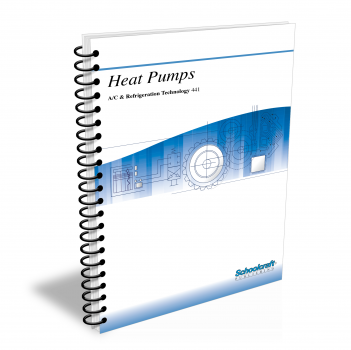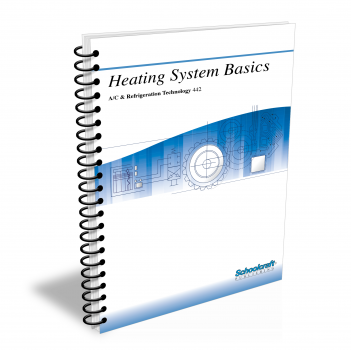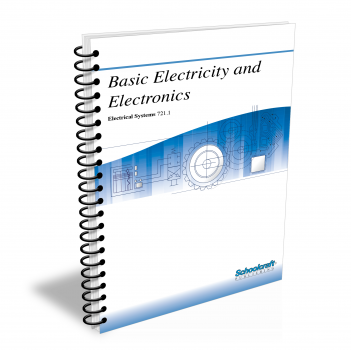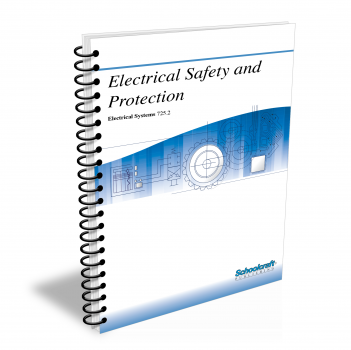Heating System Equipment
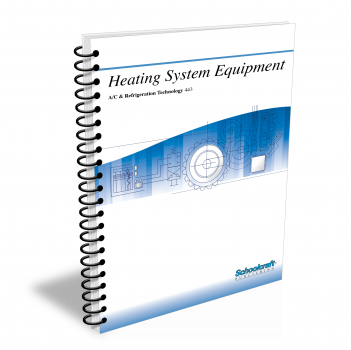
Course Number: 443
The Heating System Equipment textbook covers the hardware associated with heating systems, including gas and oil furnaces, electric systems, solid-fuel and hydroponic systems, and finally some alternative systems-solar heating, heat pumps, and fuel cells. Includes a discussion of furnace performance criteria, return air systems, and the importance of filters.
Does your curriculum require additional topics not included in this textbook? Build a customized version of the Heating System Equipment textbook below.
Recommended Contact Hours – 12
Preview a Chapter
Available Supporting Material
- Table of Contents
- Exam Copies
- Suggested Titles
Table of Contents
Chapter 1: Gas Heating Equipment
Topics: Gas heating basics; Gaseous fuels; Combustion air; Furnace categories; Furnace components for heat production, ignition, venting; Conditioned air system; Heating system controls; Service procedures
Learning Objectives:
- Describe the main parts of the furnace system, both those that produce the heat and those that distribute the heated air, and describe the four basic furnace configurations.
- Discuss the differences between natural gas and liquefied petroleum gas (LPG), the hazards associated with each fuel, and the heating rates of each fuel.
- Discuss the purposes of the primary and secondary air supplies to the combustion chamber and compare the characteristics of category I, III, and IV gas furnaces.
- Describe how the gas is introduced, mixed with the air, and burned in the heatproducing components of the furnace.
- Describe several burner ignition methods and safety shutdown measures in case of flame failure.
- Discuss the basic sequence of furnace operation and the controls required.
- Describe common service procedures for gas heating systems and discuss safety.
Chapter 2: Oil Heating Equipment
Topics: Oil heating basics; Fuel oils; Burner components; Pumps; Nozzles; Blowers; Electrodes; Transformer and controls; Fuel supply; Heat exchangers and combustion chamber; Combustion efficiency; Service procedures
Learning Objectives:
- Discuss the similarities and differences between oil furnaces and gas furnaces.
- Name two common fuel oils and discuss the relationships between grades of fuel, viscosity, and temperature.
- Compare the requirements and operation of oil burner systems having the storage tank above the furnace to those having the tank below the furnace.
- Explain the reason for atomizing fuel oil and describe nozzle action and spray patterns.
- Describe the function of blower components that provide combustion air.
- Explain the purpose of the electrodes, transformer, and controls in an oil burner system.
- Discuss various ways of testing for combustion efficiency and describe common servicing procedures for oil burner systems.
Chapter 3: Electric Heating Systems
Topics: Electric heating basics; Advantages and disadvantages of electric heating; Electric heating applications; Electric baseboard heating; Radiant ceiling heating panels; Electrically heated walls, floors; Forced-air electric furnaces; Forced-air control system; service tips
Learning Objectives:
- Describe the characteristics of the electric wire used for resistance heating elements.
- Discuss the advantages and disadvantages of electric heating systems.
- Explain how electric baseboard heating is applied to smaller facilities.
- Describe basic designs for radiant systems and discuss heating element safety.
- Describe the function of each main component in an electric forced-air furnace.
- Follow a wiring diagram to discuss the operation of an electric furnace including startup, shutdown, and safety features.
Chapter 4: Solid-Fuel Furnaces and Furnace Performance Criteria
Topics: Coal furnaces; Stoker classifications; Coal furnace control systems; Wood furnaces; Dualfuel furnaces; Furnace performance criteria
Learning Objectives:
- Explain why coal is in decline as a heating fuel and describe the layout of a coal furnace.
- Compare various kinds of mechanical stokers and explain why each kind is used.
- Describe the functions of furnace safety and operating controls.
- Discuss the basic requirements of wood-burning furnaces.
- Discuss the benefits and function of dual-fuel furnaces.
- Explain how to use furnace efficiency formulas, including the AFUE system.
Chapter 5: Hydronic Systems
Topics: Hydronic basics; Thermal, hydraulic, distribution systems; Additional system components; Radiant panel systems; Heating/cooling systems; Control methods; Domestic water heating; MTW and HTW systems; Freeze protection; Altitude considerations; Air elimination
Learning Objectives:
- Discuss how water can be used in residential and light commercial buildings to provide heating and cooling.
- Discuss the relationships between the five basic components of hydronic systems and describe the functions of the expansion tank and centrifugal pump.
- Compare the layouts and uses of series (one-pipe) and parallel (two-pipe and four-pipe) distribution systems.
- Discuss the use of radiant panels, heating/cooling systems, and domestic water heating.
- Name characteristics that make MTW and HTW systems economical for large commercial and industrial systems and explain why the simpler LTW systems are used for residences and small commercial buildings.
- Explain how to provide freeze protection, how to adjust for high altitude, and how to eliminate air from the system.
Chapter 6: Other Heating System Equipment
Topics: Fireplaces; Other in-space heaters; Solar heating; Heat pump systems; Fuel cells; Return air systems; Filters
Learning Objectives:
- Describe various kinds of fireplaces and the resulting level of efficiency.
- Discuss the three flue-venting arrangements in newer fireplaces.
- Discuss various kinds of in-space heaters and their use in residences and commercial and industrial facilities.
- Discuss the basics of solar heating and describe various kinds of solar heaters used for building cooling and heating.
- Discuss the emerging technology of fuel cells for heating and electric power generation.
- Explain why certain locations are preferred for supply and return vents in forced-air heating systems.
- Discuss today's filtration systems and IAQ concerns.
Request Exam Copies
Exam Copies
Ready to see a copy of our textbooks? After selecting which textbooks you’d like to review for your course, you can submit your request by either logging in or creating an account so we know where to ship your exam copies. A representative from Schoolcraft will contact you to confirm and finish processing your request.
Exam copies are always free and yours to keep.
Selected Exam Copies
none selected
* Maximum of five copies can be ordered
